The John Bowen Chronicles: Part 5
Red Dwarf
& the breakthrough “RD concept”
So, I had finished the four plug-ins to complete my first Big Bundle obligation. It was June 2000…and I was needing a break, after 6 months of cranking things out. The Ambient synth had taken a lot more work than I had thought – the complexities of the mod matrix routing for all those different sections, just enormous! I enjoyed the month of July without too much on my mind…..but then in August, I got another email from the customer who had pushed me to add custom stuff to the Orion, way back in the beginning. This time he wanted many more variations, add X, Y, and Z, too, while you’re at it!
I was customizing some of the synths with various colors offered, and I didn’t mind so much to address these special requests for additional functions as well, but I decided that if this was going to continue, I needed to find a better way. And then it came to me….that Better Way was a concept that I thought would really stir up the synth plug-in world – why not set up the synth to have a basic shell of a structure, and then allow for the end user to decide on the ultimate configuration? The idea of this got me tremendously excited! I didn’t know if anyone else had done this yet, but I was convinced it was an absolutely genius way to go 😀 . I thought about using the FX Insert slots that the Scope library provided – would those work for my idea, and what were the limitations? Excitedly, I opened up the FX Insert module and looked over all the provided connections (called ‘Pads’ in Scope-speak). I was very unfamiliar with the deeper details of this module, and I didn’t have any written explanation of how things worked, but I knew I could drag and drop modules into these slots, and somehow the Scope program knew to automatically connect them by some protocol, and I had to figure it out.
A lot of trial and error testing ensued. I noted how the FX modules’ pads were labeled….hmmmmm, seemed simple enough, InL and InR, OutL and OutR. That was for the stereo FX. A mono FX only showed In and Out, that’s interesting….what decides if they’re Mono or Stereo? Ah, there’s a pad for that….what about more than 2 inputs/outputs? This was crucial, because I wanted to have the Oscillators be able to (1) track frequency, (2) have waveshape control, and (3) have the ability for hard sync, which would require a separate frequency input. I looked into the Script file that made up the FX Insert module – thinking I could re-write it somehow to include expandable ins and outs (since the Scope library had a mixer module that could do that)….but I wasn’t able to ever get it to work.
Resigned to the fact that I would only ever have 2 inputs, I tried a system that had several types of modules:
- For Oscillators, I had frequency and shape for the inputs, with the audio out always on the OutL pad. (As I found later, I could also just name them In1/Out1 and In2/Out2.)
- For Filters, I had to input an audio signal on In1, leaving me a frequency control input for cutoff on In2, with no way to control Resonance externally.
- For Envelopes, one of the inputs had to be converted to a Gate/Trigger signal, while the other I used to input modulation, usually of the level (by Velocity, typically).
I took the CombPlus Pro as my start, since it was one of my simplest devices, and started removing oscillators and filters, replacing them with the FX Insert modules. Then I made a few test drop-in modules to see if the concept worked…and it did!
Based on the types of products names I was using (Orion, Dark Star), I decided on the name Red Dwarf for this new synth design (and no, I had never seen nor heard of the British SciFi series – and by the way, Orion and Dark Star were not taken from any other product, preceding other same-named items by a few months in each case). Thus came into being the Red Dwarf or RD system, with the RD series I modules. Since I was unable to present all the controls on the main surface of the ‘shell device’, I reasoned that each module would need a self-contained control surface with important parameters which the user could access by double-clicking the Insert slot (just as the Scope FX modules did). For example – for the filters, I had to add a Resonance control, since no input was possible for the module. A lot of testing different applications was done to decide just what additional parameters were needed to be provided, and this also affected how the synth shell itself would be designed.
I finished making a complete system by October, 2000. It was a two oscillator – two filter system, with bits of ideas from the Orion and Ambient. 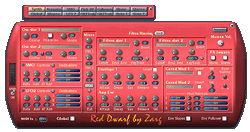
I was so excited about this approach, because it completely freed up the synth designer and end user, allowing only a basic framework or shell to be the guide…providing an easy way to use things, but a free structure where the end user could create whatever assortment of oscillators, filters, etc. , he/she wanted, within the constraints of the shell…..but even then, there were some ways around the limitations. I found I could make modules which loaded other modules – inserts within inserts within inserts – and all of the ‘daughter’ modules’ parameters could be recalled in the master presets, if you set things up correctly (more trial and error!). 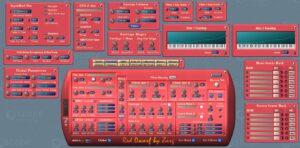
A modular approach to a manageable control surface….this was the key. (Solaris users, is this starting to sound familiar now?) Because I was trying to fit in more functions than the front surface could handle, there were a lot of ‘auxiliary control surfaces’, which where controlled by a ‘floating panel’ you could place anywhere in the screen. This was before Scope had a manageable way to ‘page’ controls on the same surface (using a button menu to replace knobs and functions with a completely new set of knobs and functions.)
At the following Frankfurt Messe, after the Red Dwarf had been out a few months, I got a rare compliment from the person who had been my supervisor, who had rejected my original designs. With the Red Dwarf, I had “pushed the Scope system farther than anyone there had expected it could go”. They also got to see the rejected plug-ins that I was now selling, and I think, bit by bit, some respect was restored. In fact, as my Zarg Music plug-ins became more well-known in the Scope community, we all realised that there was no room for any bitterness or enmity, and I made positive efforts to re-establish good relationships with all concerned.
Another person who had recently been introduced to the Scope platform was also taking notice. Hans Zimmer had started using Scope boards, reportedly due to the recent arrival of Klaus Badelt to his studio. A few months after that, I received an order for all of my synth plug-ins from Remote Control Productions, for a Jim Dooley. Not being familiar with the company name, I had several email chats back and forth with Jim before discovering that he was setting up the system for Hans! It seemed that Hans had also been particularly interested in the Red Dwarf concept, and ended up really getting into the synth design. Shortly thereafter, I was introduced to Hans via a phone call, and this started a series of ‘phone chats’ that continued for a number of years. He was so enthusiastic and supportive, and it was invaluable to be able to discuss design and ideas with someone at that level.
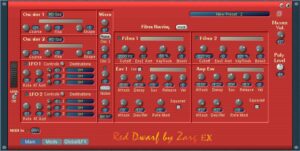 Hans asked here and there for some changes, and by September 2001 I was selling the Red Dwarf EX (expanded) version.
Hans asked here and there for some changes, and by September 2001 I was selling the Red Dwarf EX (expanded) version.
Added were things like Sample Playback options, several sets of Gated Modulator Inserts (for Envelopes or other things), and text fields to show the current preset name, and which “instance” of Red Dwarf EX was loaded (since Hans liked to have several loaded at the same time). Even though I had tried to reduce the number of auxiliary control surfaces by combining them, the nightmare was (as you can imagine by looking at the exploded view of version 1) having several of these loaded at the same time – it was a horrendous control panel problem, if you wanted some of the auxiliary panels open as well. There was no way to know which was for which synth.
It wasn’t until the new Scope 3.0 system was released that things vastly improved. The main changes were a revised preset list, and a convenient and efficient way to provide numerous sets of ‘pages’ of control surface objects. With Scope 3.0, I was finally able to re-design the Red Dwarf EX so that all of the auxiliary panels functions were available with a 3 page system.
The Red Dwarf EX v3 today…
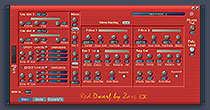
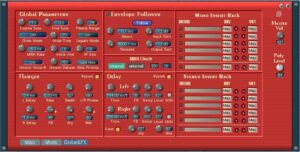
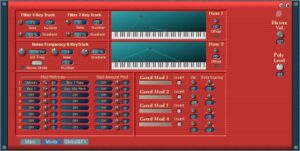
So, I hope you have enjoyed this trip back to ‘Memory Lane’. It’s been an amazing journey, which I hope to continue for many, many more years!
